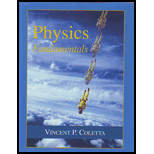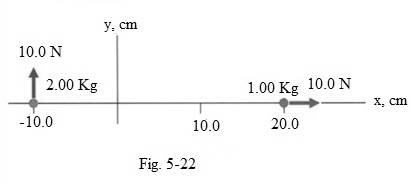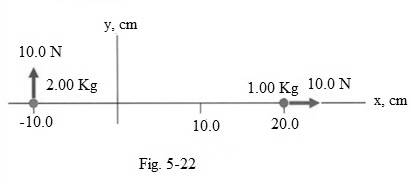
Concept explainers
(a)
To Evaluate: The position of center of mass at

(a)
Answer to Problem 34P
The position of center of mass of particles is
Explanation of Solution
Given:
The time
Formula used:
The x-coordinate of center of mass of particles shown in the figure can be calculated by the following formula:
Where
Similarly the y-coordinates can also be calculated:
Where
Calculation:
When
Substituting
Conclusion:
At
(b)
To Evaluate: The resultant force acting on the system, wherein the location of two particles, which are initially at rest, is shown in Fig. 5-22, and each particle is subject to a constant force, as indicated.

(b)
Answer to Problem 34P
System’s resultant force is calculated as
Explanation of Solution
Given:
The magnitude of the force acting on
The magnitude of force acting on
Formula used:
Formula for the resultant force
Where
Calculation:
The resultant force is being calculated as:
Conclusion:
Thus, the system’s resultant force
(c)
To Evaluate: The location of center of mass at

(c)
Answer to Problem 34P
At
Explanation of Solution
Given:
The magnitude of the force acting on
The magnitude of force acting on
Formula used: It is known that
Where
The x-coordinate of center of mass of particles shown in the figure can be calculated by the following formula:
Where
Similarly the y-coordinates can also be calculated:
Where
Calculation:
As a constant force is acting on each particle, the acceleration of particle
Substituting
Position of particle
When the particle is at rest the velocity
Substituting
Similarly the acceleration of
Substituting
And position of
Substituting values of
At
Substituting
Similarly the y-coordinate of center of system’s mass is calculated at
Substituting
The
Conclusion:
Thus, the location of center of mass at
Want to see more full solutions like this?
Chapter 5 Solutions
Physics Fundamentals
- According to legend, Galileo Galilei dropped two balls of different mass from the top of the leaning tower of Pisa in 1589. Whether or not this public experiment ever took place, Galileo was able to demonstrate that, contrary to Aristotle’s teaching, all bodies fall at the same rate regardless of mass, assuming that one is not so tenuous that it is slowed by air resistance. In this experiment, an equation is presented relating the acceleration of gravity at Earth’s surface, g, to the height that an object falls from, h, and the time it takes the object to reach the ground, t. Gravity acceleration at Earth’s surface has been measured many times. In British Imperial Units, Small Metric Units, and Large Metric Units, the standard values of g are: g = 32 feet per second-squared (ft/s2) g = 980 centimeters per second-squared (cm/s2) g = 9.8 meters per second-squared (m/s2). Theory Newton succeeded in explaining gravitational acceleration using his Laws of…arrow_forwardA 2.7 kg mass is initially t rest while upon a horizontal surface. An applied force f 16 N is exerted on the mass at an angle of -29 degrees with respect to the +x direction. If the coefficient of kinetic friction is 0.213 what is the magnitude of the acceleration produced?arrow_forwardIn a soccer match against Mexico in 2014, US Women’s National Team striker Alex Morgan scored a sweetheaded goal in the 79th minute of the game. Just as the ball left her head, the horizontal component of its acceleration was 225 m/s , and the vertical component of its acceleration was -200 m/s (assuming thepositive direction points up). If the ball has a mass of 425 g, what was the magnitude and direction of theforce she applied to the ball? Note- you can ignore the weight of the ball.arrow_forward
- •7SSMThere are two forces on the 2.00 kg box in the overhead view of Fig. 5-31, but only one is shown. For F1 = 20.0 N, a = 12.0 m/s2, and θ = 30.0°, find the second force (a) in unit-vector notation and as (b) a magnitude and (c) an angle relative to the positive direction of the x axis.arrow_forwardDescribe a situation in which the net external force on a system is not zero, yet its speed remains constant.arrow_forwardA particle of mass 2.4 kg is subject to a force that is always pointed towards the North but whose magnitude changes quadratically with time. Let the y-axis point towards the North. The magnitude of the force is given as F = 6t2, and has units of newtons Determine the change in velocity Δv, in meters per second, of the particle between t=0 and t=1.3s. Determine the change in y coordinate, in meters, of the particle Δ y betweent=o and t=1.3 if the initial velocity= 15.9 m/s and directed North, in the same direction as the force.arrow_forward
- A barefoot field-goal kicker imparts a speedof 27 m/s to a football initially at rest.If the football has a mass of 0.59 kg and thetime of contact with the ball is 0.034 s, whatis the magnitude of the force exerted by theball on the kicker’s foot?Answer in units of N.arrow_forwardIn the following figure, the horizontal surface onwhich this block slides is frictionless. If the two forcesacting on it each have magnitude F = 30.0 N andM = 10.0 kg , what is the magnitude of the resultingacceleration of the block?arrow_forwardFind the center of mass of a rod of length L whose mass density changes from one end to the other quadratically. That is, if the rod is laid out along the x-axis with one end at the origin and the other end at x=L , the density is given by (x)=0+(10)(xL)2 , where 0 and 1 are constant values.arrow_forward
- Three skydivers are plummeting earthward. They are initially holding onto each other, but then push apart. Two skydivers of mass 70 and 80 kg gain horizontal velocities of 1.2 m/s north and 1.4 m/s southeast, respectively. What is the horizontal velocity of the third skydiver, whose mass is 55 kg?arrow_forwardThe x and y coordinates of a 4.00-kg particle moving in the xy plane under the influence of a net force F are given by x = t4 6t and y = 4t2 + 1, with x and y in meters and t in seconds. What is the magnitude of the force F at t = 4.00 s?arrow_forwardIf the only forces acting on a 2.0kg mass are F1=(3i-8j)N and F2=(5i+3j)N, what is the magnitude of the acceleration of the particle?arrow_forward
 Physics for Scientists and Engineers: Foundations...PhysicsISBN:9781133939146Author:Katz, Debora M.Publisher:Cengage Learning
Physics for Scientists and Engineers: Foundations...PhysicsISBN:9781133939146Author:Katz, Debora M.Publisher:Cengage Learning University Physics Volume 1PhysicsISBN:9781938168277Author:William Moebs, Samuel J. Ling, Jeff SannyPublisher:OpenStax - Rice University
University Physics Volume 1PhysicsISBN:9781938168277Author:William Moebs, Samuel J. Ling, Jeff SannyPublisher:OpenStax - Rice University

